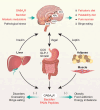GABAB Receptor: Structure, Biological Functions, and Therapy for Diseases
- PMID: 40242161
- PMCID: PMC12000685
- DOI: 10.1002/mco2.70163
GABAB Receptor: Structure, Biological Functions, and Therapy for Diseases
Abstract
Gamma-aminobutyric acid (GABA) B receptors (GABABRs) that acts slowly and maintains the inhibitory tone are versatile regulators in the complex nervous behaviors and their involvement in various neuropsychiatric disorders, such as anxiety, epilepsy, pain, drug addiction, and Alzheimer's disease. Additional study advances have implied the crucial roles of GABABRs in regulating feeding-related behaviors, yet their therapeutic potential in addressing the neuropsychiatric disorders, binge eating, and feeding-related disorders remains underutilized. This general review summarized the physiological structure and functions of GABABR, explored the regulation in various psychiatric disorders, feeding behaviors, binge eating, and metabolism disorders, and fully discussed the potential of targeting GABABRs and its regulator-binding sites for the treatment of different psychiatric disorders, binge eating and even obesity. While agonists that directly bind to GABABR1 have some negative side effects, positive allosteric modulators (PAMs) that bind to GABABR2 demonstrate excellent therapeutic efficacy and tolerability and have better safety and therapeutic indexes. Moreover, phosphorylation sites of downstream GABABRs regulators may be novel therapeutic targets for psychiatric disorders, binge eating, and obesity. Further studies, clinical trials in particular, will be essential for confirming the therapeutic value of PAMs and other agents targeting the GABABR pathways in a clinical setting.
Keywords: GABAB receptors; allosteric modulator; binge eating; metabolism disorders; molecular signaling; psychiatric disorders.
© 2025 The Author(s). MedComm published by Sichuan International Medical Exchange & Promotion Association (SCIMEA) and John Wiley & Sons Australia, Ltd.
Conflict of interest statement
The authors declare no conflicts of interest.
Figures





References
-
- Flegal K. M., “BMI and Obesity Trends in Chinese National Survey Data,” Lancet 398, no. 10294 (2021): 5–7. - PubMed
-
- Swinburn B. A., Kraak V. I., Allender S., et al., “The Global Syndemic of Obesity, Undernutrition, and Climate Change: The Lancet Commission Report,” Lancet 393, no. 10173 (2019): 791–846. - PubMed
-
- Wang Y., Xue H., Sun M., Zhu X., Zhao L., and Yang Y., “Prevention and Control of Obesity in China,” The Lancet Global Health 7, no. 9 (2019): e1166–e1167. - PubMed
-
- Wang Y., Zhao L., Gao L., Pan A., and Xue H., “Health Policy and Public Health Implications of Obesity in China,” The Lancet Diabetes & Endocrinology 9, no. 7 (2021): 446–461. - PubMed
Publication types
LinkOut - more resources
Full Text Sources
